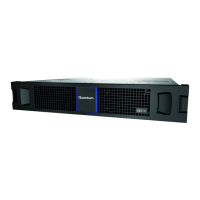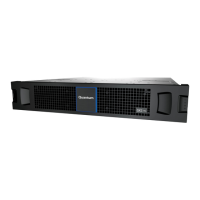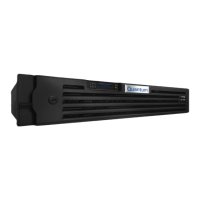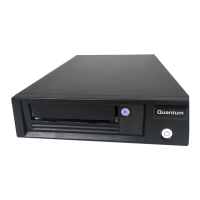Do you have a question about the Quantum QX Series and is the answer not in the manual?
Details about QXS-3 Series storage systems, including drive configurations and front panel LEDs.
Information on QXS-4 Series and StorNext storage systems and their configurations.
Diagram and description of rear panel components for 2U12, 2U24, and 2U48 RAID chassis.
Overview of the 4U56 drive system, including chassis and component details.
Information on QXS-6 Series storage systems, including drive chassis types.
Details about the QXS-648 system, including drive chassis and bezel sub-assembly.
Information on the QXS-656 system, including drive chassis and bezel sub-assembly.
Procedures for installing and replacing various QXS storage components.
Explanation of write-back, write-through, and read-ahead caching mechanisms.
Details about the CompactFlash card's role in cache backup and recovery.
Explanation of the supercapacitor pack's function in protecting controller module cache.
Step-by-step checklist for installing RAID and expansion chassis and initial configuration.
Details on NEBS Level 3 compliance requirements and exceptions for the product.
Instructions for installing LFF and SFF drives into 2U12 and 2U24 chassis.
Procedures for populating 48-drive chassis drawers with drives and AMS inserts.
Instructions for installing drives into the 4U56 chassis and drawer diagrams.
Information on using Full Disk Encryption (FDE) capable drive modules and related procedures.
Guidelines and tables for connecting RAID and expansion chassis systems.
Lists supported and unsupported QXS Hybrid and StorNext configurations.
Illustrations of reverse cabling methods for QXS, QXS-3, and QXS-4 series chassis.
Illustrations of straight-through cabling methods for QXS, QXS-3, and QXS-4 series chassis.
Cabling illustrations for QXS-6 series drive chassis, including reverse and straight-through methods.
Procedures for testing chassis connections and verifying functionality.
Detailed procedures for powering on and off the system, including switchless and DC power supplies.
Requirements for host operating systems, including multipathing support and native DSM usage.
Common cabling configurations for hosts, chassis, and switches, including replication setup.
Describes host interface protocols and common cabling configurations for connecting chassis to hosts.
Explanation of Converged Network Controller (CNC) technology and SFP transceiver usage.
Details on Fibre Channel protocol support, topologies, and port usage for host connection and replication.
Information on 10GbE iSCSI protocol support, host port configuration, and authentication.
Details on 1 Gb iSCSI protocol support, host port configuration, and authentication.
Explanation of high-density mini-SAS interface protocol and its usage for host connection.
Illustrations of direct attach configurations for connecting servers to controller host ports.
Instructions for connecting to FC host interface ports using CNC ports and qualified FC SFPs.
Instructions for connecting to 10GbE iSCSI host interface ports using CNC ports and qualified SFPs.
Instructions for connecting to 1Gb iSCSI host interface ports using CNC ports and qualified RJ-45 SFPs.
Instructions for connecting to HD mini-SAS host interface ports using SFF-8644 cables.
Explanation of dual-controller configurations and the benefits of application availability.
Illustrative examples of dual-controller connections to hosts for 12-, 24-, and 48-drive systems.
Illustrative examples of 56-drive system connections to hosts, including direct attach configurations.
Explanation of SANs using switches to connect servers and RAID chassis for shared storage.
Illustrations of switch-connect configurations for multiple servers and switches.
Illustrations of 12-, 24-, and 48-drive systems with multiple servers and switches.
Illustrations of 56-drive systems with multiple servers, switches, and SAN fabric.
Information on iSCSI considerations, including IP address schemes and port configurations for different models.
Steps to change CNC port mode from default FC to iSCSI or FC-and-iSCSI combination.
Instructions for connecting a management host to the storage system over an Ethernet network.
Details on replication feature for disaster recovery, supporting virtual and linear storage environments.
Examples of replication configurations for CNC-based RAID chassis, showing linear and virtual replication.
Information on QXS-3 series CNC ports and replication capabilities, including SFP options.
Information on rear panel of two RAID chassis with I/O and replication on the same network.
Information on CNC host interface connections and replication using two switches for protection.
Use of VLAN and zoning for separate networks for iSCSI and FC across different locations.
Information on rear panel of two RAID chassis with I/O and replication on the same physical network.
Information on CNC host interface connections and replication using two switches for optimal protection.
Use of VLAN and zoning for separate networks for iSCSI and FC across different locations.
Information on rear-panel of two RAID chassis with I/O and replication on different networks for disaster recovery.
Procedures for verifying and updating controller firmware to ensure compatibility.
Procedures for configuring network port IP addresses using DHCP or the CLI.
Steps to obtain IP addresses, subnet masks, and gateway values from a DHCP server.
Manual configuration of network port IP addresses using CLI commands.
Brief introduction to CLI and Disk Storage Management Utility for system setup.
Explanation of Command Line Interface (CLI) software for managing and monitoring storage systems.
Options for accessing the CLI and signing in using default or configured credentials.
Description of the web-based Disk Storage Management Utility (WBI) for system configuration and management.
Recommended browser settings and configurations for optimal display and functionality.
Steps to sign in to the Disk Storage Management Utility using IP address and credentials.
Features that can impact performance and recommendations for minimizing negative impacts.
Purpose of troubleshooting procedures for verifying hardware setup during initial configuration.
Information on connecting to the CLI port via USB and potential driver or parameter requirements.
Basic methodology for isolating faults within a storage system and identifying affected FRUs.
General steps for fault isolation, including gathering information, checking LEDs, and reviewing logs.
Various options for performing basic troubleshooting steps using DSMU, CLI, event logs, and chassis LEDs.
How to gather information about a fault, including reviewing reported issues and checking system components.
Using chassis LEDs and management interfaces to identify the location and nature of a fault.
Importance of reviewing event logs for fault identification, severity levels, and recommended actions.
Process of isolating a fault to specific components within the data path.
Steps to take if a chassis fails to initialize, including rescanning and power cycling.
Procedure to correct chassis IDs when they do not match the physical cabling order.
CLI command to perform a rescan of the system for chassis ID correction.
Steps to rescan disk channels using the V2 Disk Storage Management Utility.
Procedures for stopping I/O to affected vdisks as a precaution during troubleshooting.
Table of diagnostic steps for various LED status conditions on front and rear panels.
Troubleshooting guide for an amber "Fault/Service Required" LED on the chassis front panel.
Troubleshooting guide for an off "FRU OK" LED on the controller rear panel.
Troubleshooting guide for an amber "Fault/Service Required" LED on the controller rear panel.
Troubleshooting guide for an amber "Fault/Service Required" LED on the drawer panel.
Troubleshooting steps when both drive module LEDs are off.
Troubleshooting guide for an amber "Fault" LED on the drive module.
Troubleshooting guide for an off "Host Link Status" LED on a connected host port.
Troubleshooting guide for an off "Expansion Port Status" LED on a connected port.
Troubleshooting guide for an off "Network Port Link Status" LED on a connected port.
Troubleshooting guide for an amber "Fault/Service Required" LED on the fan control module.
Troubleshooting guide for an off "Input Power Source" LED on the power supply.
Troubleshooting guide for an amber "Voltage/Fan Fault/Service Required" LED on the power supply.
Procedure for preserving cache data by transporting CompactFlash from a failed controller.
Procedure to troubleshoot connection faults with CNC ports on host-side connections.
Detailed steps for troubleshooting host-side connection issues with CNC ports.
Procedure to troubleshoot connection faults with SAS host ports.
Detailed steps for troubleshooting host-side connection issues with SAS host ports.
Procedure to isolate faults related to controller module expansion port connections.
Procedures for isolating and troubleshooting issues with the replication feature.
Examples of replication configurations for CNC-based RAID chassis, showing linear and virtual replication.
Steps to prepare and verify replication using disk management utility or CLI.
Troubleshooting guide for virtual replication issues using the V3 disk management utility.
Troubleshooting guide for virtual replication issues using the V2 disk management utility.
Troubleshooting steps when unable to replicate a volume or create a replication set.
Steps to check if a replication run was successful and troubleshoot failures.
Procedures for resolving voltage and temperature warnings by checking fans and system health.
Description of sensor locations for monitoring conditions within chassis components.
Information on power supply sensors monitoring voltage, current, temperature, and fans.
Details on cooling fan sensors, their normal operating range, and fault conditions.
Information on temperature sensors within controller modules and power supplies, including shutdown values.
Description of power supply voltage sensors and their operating ranges.
Explanation of QX/QXS cache status LED behavior during flush and self-refresh modes.
Information on LEDs for 12-, 24-, and 48-drive chassis, including front and rear panel components.
Description of front panel LEDs for the 12-Drive RAID Chassis (2U12), with bezel installed and removed.
Description of front panel LEDs for the 24-Drive RAID Chassis (2U24), with bezel installed and removed.
Description of front panel LEDs for the 48-Drive RAID Chassis (2U48), with bezel installed and removed.
Description of drive LEDs for 3.5" LFF and 2.5" SFF drives, including Power/Activity and Fault indicators.
Information on LEDs for the 56-Drive RAID Chassis (4U56), including bezel installed and removed views.
Description of front panel LEDs visible with the chassis bezel installed on the 4U56 chassis.
Description of front panel LEDs visible after removing the chassis bezel on the 4U56 chassis.
Description of drive LEDs for LFF and SFF drives in the 4U56 chassis, including Power/Activity and Fault indicators.
Information on LEDs for the 56-Drive Expansion Chassis, including rear panel components.
Requirements and guidelines for site preparation, including location selection and environmental considerations.
Requirements for AC power input, including voltage, frequency, and circuit breaker specifications.
Requirements for DC power input, including voltage ranges and bonding network considerations.
Guidelines for chassis weight, lifting, rack installation, and orientation for stability.
Guidelines for single-phase power systems, earth ground connection, and avoiding electric shock.
Guidelines for ensuring adequate airflow and cooling clearance for chassis components.
Guidelines for routing and managing cables, staying within length limitations, and avoiding interference.
Recommended requirements for a management host, including USB connection and Ethernet networking.
Chassis dimensions, weights, and construction details for installation and operation.
Information on preventing ESD damage to systems and handling static-sensitive parts.
Methods and precautions for proper grounding when handling or installing electrostatic-sensitive parts.
Description of the rear panel USB CLI port for direct connection to a management computer.
Details on the USB CLI port for initial IP address setting and configuration tasks.
Function of the Emulated Serial Port interface for management computer detection and serial port configuration.
List of supported applications that facilitate connection to QXS Storage controllers.
Information on device driver or special operation mode requirements for certain operating systems.
Details on USB serial port driver requirements and obtaining the Quantum device driver for Windows.
Information on parameters required for Linux driver loading to recognize QXS Storage chassis.
Command to load Linux device driver with parameters for controller recognition.
Overview of SFP transceiver options for CNC controller modules and installation guidelines.
Guidance on locating qualified SFP options within the product ship kit and general appearance.
Step-by-step procedure for installing an SFP transceiver into a target CNC port.
How to view CNC port LEDs to verify connection and link status after SFP installation.
| Category | Storage |
|---|---|
| Capacity | Varies by model |
| Product Line | QX Series |
| Interface | SAS, SATA |
| RAID Levels | 0, 1, 5, 6, 10 |
| Form Factor | Rackmount |
| Power Supply | Redundant (Varies by model) |
| Cooling | Hot-swappable fans |











